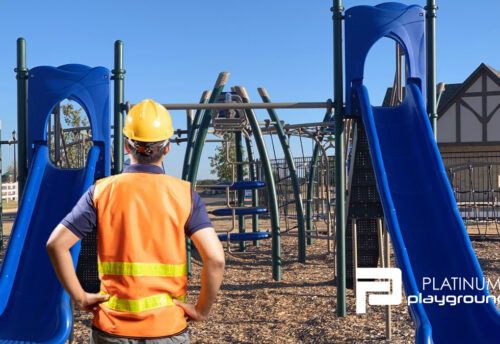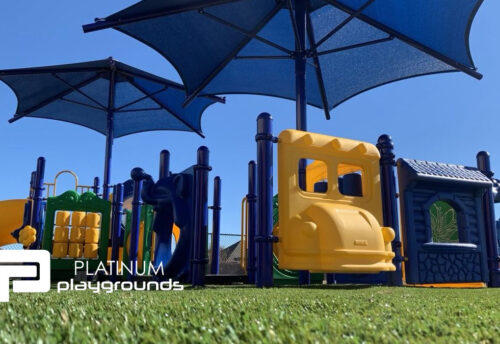Inclusive Play Equipment: Creating Environments Everyone Can Enjoy
Imagine inclusive play equipment where every child, regardless of ability, can swing, slide, climb, and explore with confidence and joy. Thoughtful playground design has come a long way in recent years, evolving from traditional one-size-fits-all structures to intentional designs that cater to children of all abilities, including those with mobility challenges, sensory needs, or developmental disabilities. An inclusive playground is more than a set of accessible structures; it’s a welcoming space that fosters social interaction, physical activity, and boundless fun for every child.
Need an overall look at options? Check out: “Types of Commercial Playground Equipment From Slides to Climbers, Here’s What you Need to Know“.
This guide dives into the world of inclusive play equipment, covering the benefits, options, and tips for creating an accessible play area that meets every child’s needs. And when it comes to designing the perfect inclusive playground, Platinum Playgrounds is your go-to partner, helping you make choices that turn your vision into a reality.

Why Inclusive Play Equipment Matters
Inclusive playgrounds break down physical, social, and cognitive barriers, giving every child an equal opportunity to play, grow, and make memories. These spaces provide children of all abilities with the chance to engage in physical play, interact socially, and develop essential motor skills. But inclusivity isn’t just about access—it’s about creating a sense of belonging and understanding among children, parents, and communities. When kids learn to play together, regardless of ability, they also learn about empathy, acceptance, and understanding.
Essential Features of Inclusive Play Equipment
The best inclusive playgrounds consider a few critical factors: accessibility, engagement, and sensory variety. Let’s take a look at some popular features and equipment choices that help create a playground for everyone.
1. Accessible Pathways
It all starts with accessibility. Wide, smooth pathways ensure that children using wheelchairs, walkers, or other mobility aids can access every part of the playground. These paths should connect all major play zones and have gentle slopes, so no part of the playground is off-limits.
Did You Know? The Americans with Disabilities Act (ADA) provides standards to help create playgrounds that are accessible and enjoyable for all. Platinum Playgrounds is well-versed in ADA compliance and can guide you in meeting these essential standards.
2. Adaptive Swings
Adaptive swings are a must for inclusive playgrounds. While traditional swings are fantastic for many children, they can be difficult for those with limited mobility or stability. Adaptive swings offer extra support and harnesses, allowing children of all abilities to feel the wind in their hair without sacrificing safety.
Types of Adaptive Swings:
- Bucket Swings: Deep-seated swings with high backs, ideal for children needing more torso support.
- High-back Seats with Harnesses: These come with a supportive back and secure harness, allowing children with more severe mobility challenges to join in on the swinging fun.
3. Transfer Stations
Transfer stations are small platforms that help kids using wheelchairs move onto other play structures. These stations should be well-integrated into the playground layout, connecting to slides, climbing structures, or balance beams.
Pro Tip: Ensure transfer stations are in shaded areas, so kids can take their time transitioning without feeling rushed. Platinum Playgrounds can help you strategize the perfect layout to make sure these stations are accessible and comfortable.
Inclusive Play Equipment: Engaging All the Senses
Sensory play is essential for children with and without disabilities, as it helps with brain development, attention, and social skills. Sensory play equipment engages sight, sound, touch, and sometimes even smell, making it a critical component of an inclusive playground.
4. Musical Instruments
Outdoor musical instruments, such as drums, chimes, and xylophones, provide a fantastic opportunity for sensory engagement. Kids of all abilities can experiment with sound, rhythm, and movement, enhancing their creativity while having fun.
Bonus: Musical instruments allow children to interact without needing advanced physical abilities or complex instructions, making them accessible to a broad age and ability range.
5. Tactile Play Panels
Tactile play panels are designed with textures, colors, and shapes that children can touch and manipulate. They are perfect for kids with sensory processing disorders, providing a calming, focused activity. These panels may include spinning gears, sliding beads, or textured surfaces that invite kids to explore and engage with their environment.
6. Water and Sand Play Tables
Water and sand tables offer sensory experiences that are both calming and educational. By providing scoops, funnels, and tools, kids can interact with materials, improving fine motor skills and coordination. Accessible sand and water tables are built with space underneath so children in wheelchairs can easily roll up and join the activity.
Learn about other “Popular Playground Equipment Choices for Fun & Safe Play“.
Inclusive Climbing and Balance Play Equipment
Everyone loves climbing and balancing, and adaptive designs make these classic playground features available to children of all abilities.
7. Low Ramps and Bridges
Not all climbing structures need to be high or complex. Ramps and bridges, especially those with handrails or grips, are excellent for inclusive play. They allow children of all abilities to experience the thrill of reaching new heights and encourage social interaction between kids as they explore together.
8. Wide-Platform Balance Beams
Balance beams with wide, sturdy platforms let kids with varying degrees of balance or mobility join in. They provide a challenge for some, while offering extra stability for those who need it. Adding handrails to balance beams also makes them more accessible for children needing extra support.
9. Seated Spinners
Seated spinners offer a twist on the classic playground spinner, allowing kids to sit securely while spinning at their own speed. These spinners often have back support and a low, stable base to ensure they’re safe for children with limited balance.
Don’t forget about your “Interactive and Modern Playground Equipment“ options!
Additional Tips for Selecting Inclusive Play Equipment
Creating an inclusive playground takes careful planning and attention to detail. Here are some extra tips to keep in mind:
- Shade and Rest Areas: Make sure your playground has shaded benches or tables for kids to rest and for caregivers to supervise comfortably.
- Sensory Variety: Balance active play equipment with quieter, sensory-focused play zones to offer kids a place to recharge and explore.
- Multi-Level Play: Think about the playground in layers. Ground-level play structures, like musical panels and low ramps, allow children with physical disabilities to stay involved in the action even if they can’t climb high.
With the right planning, you can create a playground that invites children of all abilities to connect, learn, and have fun. And with Platinum Playgrounds by your side, you can be confident that your playground will be safe, engaging, and accessible to everyone.
Let Platinum Playgrounds Help You Choose the Right Inclusive Play Equipment
Building an inclusive playground doesn’t have to be overwhelming. Platinum Playgrounds has years of experience in designing ADA-compliant, accessible play areas that support the needs of all children. From adaptive swings to sensory panels, we offer a wide range of inclusive equipment that brings communities together and fosters unforgettable play experiences.
Ready to make your playground inclusive? Contact Platinum Playgrounds today to explore equipment options and create a play space where every child can play, laugh, and grow together.


